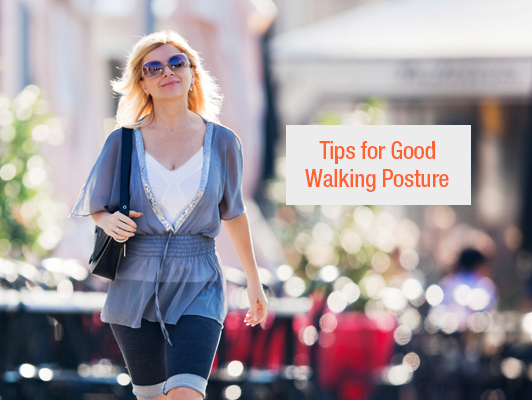Tips for good walking posture
Today on my lunch walk I noticed something: A lot more people are getting out and walking at lunch. But as I watched the busy lunch crowd swiftly walking past, I also noticed that some of the walkers have really bad walking posture that could be affecting other areas of their health.
Starting a walking program is one of the safest and least expensive ways to exercise and improve your health. So I don’t want anyone to think that walking is in any way bad for you. But yes, walking posture matters! Every step you take is working multiple muscle groups in your body and potentially causing added strain and bad posture habits. Here are our tips for getting started on a stronger stride!
- Head up: Keep your head elongated as if a string is gently pulling it upward. This will ensure your neck is in alignment and help keep you moving at a brisk pace.
- Eyes forward: Keep your eye on the horizon ahead to help you stand taller, and also prevent stress on your shoulders and neck.
- Chest up and shoulders down: Keeping the chest up can help prevent hunching and slouching. Keeping the shoulders down will help you avoid upper back and neck tension.
- Keep your tummy tight: Focus on tightening your abs. That will help support proper alignment as well as take pressure off your back.
- Bend your arms: Keeping your arms at your sides can actually slow you down when walking. By bending your arms and letting them swing back and forth opposite leg motion as you walk, you are not only getting more speed, you are also keeping the natural posture.
- Stride forward: Aim to keep a neutral pelvis and avoid tucking your tailbone while walking. Also keep the knees and toes pointed forward and the front leg straight but not locked for a smooth stride forward. Making sure that you are naturally propelling forward will help prevent injury.
- Focus on feet: As you walk, focus on heel to toe walking. This means push off from your heel and roll through the toe as you step forward. This action will carry your farther and faster.
These points may seem like a lot to incorporate all at once — so don’t. My advice is to know that when adding in new techniques you may be slower than usual, and that’s normal. Add in one technique at a time and gradually add others until you have mastered all of the techniques (which may take time). The longer you work at it, the better you will get. Before long, you will be moving more efficiently and saving your posture!



